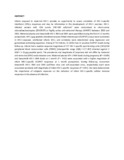Maternal plasma and breastmilk viral loads are associated with HIV‐1‐specific cellular immune responses among HIV‐1‐exposed, uninfected infants in kenya

View/
Date
2015Author
Liu, A. Y.
Lohman-Payne
Chung, M. H.
Kiarie, J.
Kinuthia, J.
Slyker, J
Richardson, B.
Lehman, D.
Farquhar, C.
John-Stewart, G.
Language
enMetadata
Show full item recordAbstract
Infants exposed to maternal HIV-1 provide an opportunity to assess correlates of HIV-1-specific interferon (IFN)-γ responses and may be informative in the development of HIV-1 vaccines. HIV-1-infected women with CD4 counts 200–500 cells/mm3 were randomized to short-course zidovudine/nevirapine (ZDV/NVP) or highly active anti-retroviral therapy (HAART) between 2003 and 2005. Maternal plasma and breastmilk HIV-1 RNA and DNA were quantified during the first 6–12 months postpartum. HIV-1 gag peptide-stimulated enzyme-linked immunospot (ELISPOT) assays were conducted in HIV-1-exposed, uninfected infants (EU), and correlates were determined using regression and generalized estimating equations. Among 47 EU infants, 21 (45%) had ≥1 positive ELISPOT result during follow-up. Infants had a median response magnitude of 177 HIV-1-specific spot-forming units (SFU)/106 peripheral blood mononuclear cells (PBMC) [interquartile range (IQR) = 117–287] directed against 2 (IQR = 1–3) gag peptide pools. The prevalence and magnitude of responses did not differ by maternal anti-retroviral (ARV) randomization arm. Maternal plasma HIV-1 RNA levels during pregnancy (P = 0·009) and breastmilk HIV-1 DNA levels at 1 month (P = 0·02) were associated with a higher magnitude of infant HIV-1-specific ELISPOT responses at 1 month postpartum. During follow-up, concurrent breastmilk HIV-1 RNA and DNA (cell-free virus and cell-associated virus, respectively) each were associated positively with magnitude of infant HIV-1-specific responses (P = 0·01). Our data demonstrate the importance of antigenic exposure on the induction of infant HIV-1-specific cellular immune responses in the absence of infection.
Citation
Liu, A. Y., Lohman‐Payne, B., Chung, M. H., Kiarie, J., Kinuthia, J., Slyker, J., ... & John‐Stewart, G. (2015). Maternal plasma and breastmilk viral loads are associated with HIV‐1‐specific cellular immune responses among HIV‐1‐exposed, uninfected infants in Kenya. Clinical & Experimental Immunology, 180(3), 509-519.Publisher
University of Nairobi
Collections
- Faculty of Health Sciences (FHS) [10415]
